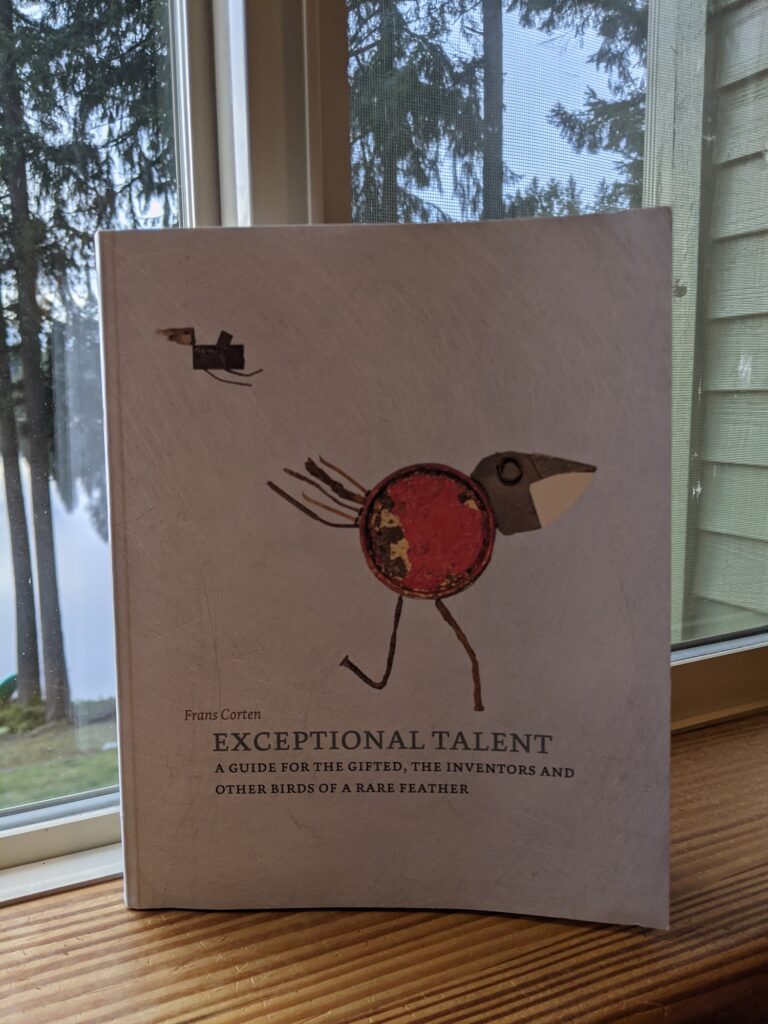
So much has been going on with pandemic parenting these days that I haven’t spent as much time exploring giftedness in adults – with one exception: reading Frans Corten’s delightful book Exceptional Talent: A Guide for the Gifted, The Inventors, and Other Birds of a Rare Feather (2021), recently translated into English from Dutch.*
Corten opens his book with the following quote:
“If you stick a bird in a cage, flying will become a disorder instead of a talent.”
This reminds me of the following oft-used cartoon in educational circles:

By “birds of a rare feather”, Corten is referring to people with exceptional talents – i.e., rainforest minded people, or gifted adults. Corten has spent years coaching such individuals, and shares his many insights and experiences in this beautifully illustrated text, clearly made with aesthetic appeal in mind.
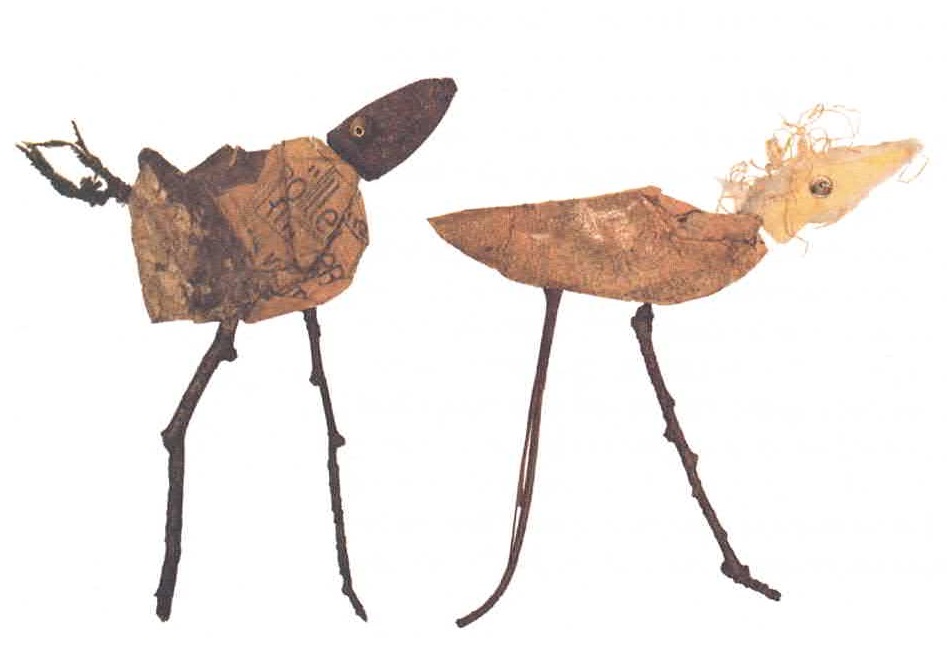
Corten open his book in Chapter 1 by explaining “Why This Guide?” (“to help exceptional talents find their way in their lives and work”), and sharing his own story with giftedness.
In Chapter 2 (“Exceptional Talent Does Not Flourish Of Its Own Accord”), Corten offers a valuable reminder of the reasons why gifted individuals almost always require additional support to thrive, despite widespread assumptions that “high intelligence in itself will make sure that the person finds their niche” (p. 14). On the contrary, Corten estimates that “the percentage of gifted people who are mental healthcare clients, who live on benefits or are homeless is substantially higher than the percentage in society” (p. 15) – a statistic I personally don’t doubt for a moment.
[As a brief side note, I grew up in a fringe spiritual group in which nearly all the adult members were likely gifted to some extent – and many did indeed struggle with mental health concerns, career issues, and/or ongoing financial or housing instability. In another post, I plan to write in more detail about the intriguing correlations I see between giftedness, spirituality, and life challenges.]
Back to Corten’s book, he acknowledges that “exceptional talents have too few role models as examples” given that “the usual career pathways and tests don’t always work well” – something I’ve most definitely found to be true for myself, as well as for plenty of the rainforest-minded graduate students I’ve mentored over the years.
In Chapter 3, Corten concedes, “I can’t offer you a scientific definition of an exceptional talent. The essence is that your talent really belongs to the exceptions, leaving you to discover many things for yourself” (p. 18). He offers a useful chart on page 18 of how individuals with exceptional talent may perceive situations in their workplace, versus how their employers view them. To provide just a couple of examples:
- A workplace might feel that an employee has “many conflicts with management and authorities”, while the individual believes about herself, “I have a strongly developed sense of justice”.
- A workplace might characterize an employee as having “poor timing, in meetings for example” while the individual feels, “I’m constantly meeting resistance; it all goes so slowly.”
This chart reminds me of the ones provided by Mary-Elaine Jacobsen in her book The Gifted Adult (1999), in which she represents the two extremes (“collapsed” and “exaggerated”) of intensity, complexity, and drive as manifested in a variety of ways, while also providing a more “balanced” ideal for each. The ultimate goal of both authors is to encourage flourishing.
Corten points out that very often the “high flyers” of large organizations are flourishing; his book is not designed for them, but rather for those who exhibit the “typical characteristics” of exceptional talent:
- heightened powers of observation
- vulnerability
- combinations of talents
- uniquely innovative
- a tendency to “think and speak too fast for other people to keep up, often without knowing” (p. 22).
He follows up on these ideas in Chapter 4 (entitled “A Large Gap”) by noting, “The essence of being exceptional is that you deviate greatly from the average” (p. 23). He reminds readers that it’s important not to assume “that people are deliberately thwarting you” but instead to keep in mind that most “people can’t see what you see, can’t easily make the connections you make, can’t think through the consequences of a decision as far ahead. You just go far too fast.”
This echoes the advice in Jim Webb’s book Searching for Meaning (2015), in which he writes: “Once you stop denying the differences that exist between yourself and others, you can appreciate your abilities. You also may find that you appreciate the uniqueness of others.” (p. 119).
I’m also reminded of the Giftedness Knows No Boundaries public awareness campaign put forth by the National Association for Gifted Children (NAGC) in 2016, which emphasizes the key phrases “See Me, Know Me, Challenge Me, Teach Me”. In order to meet the needs of gifted individuals of all ages, we must first see them – but a key difference is that with children, the onus and moral responsibility for this lies on the adults around them, whereas gifted adults must learn to advocate for themselves. This is tricky business – especially for those who weren’t adequately supported in their younger years.
In Chapter 5, Corten advises us not to adapt, but rather to adjust, and reminds us once again that “the first step is realising that most other people don’t see” your exceptional talent, given that they “come from another world in terms of thinking and doing and that’s just how it is” (p. 35).
Corten recommends the following strategies: looking for soulmates; opening up; using expressive language; finding your way around social media; learning to ‘mix and match’; appreciating what you get; taking your feelings seriously; speaking in the first person; making your needs the starting point; being okay with mistakes; considering the correlation (if any) between money and worth; and creating “space and peace” for yourself.
There is a lot covered in this chapter, and it’s worth reading closely while taking notes. I personally have found solace in many of the ideas here, and also recognize a number of them from other readings I’ve done. For instance, the notion of learning to “mix and match” to create a fulfilling and viable career is discussed in Emilie Wapnick’s How To Be Everything: A Guide For Those Who (Still) Don’t Know What They Want to Be When They Grow Up (2017), and is a direction I’ve ended up following for myself.
Meanwhile, making peace with – i.e., “finding your way around” – social media is invaluable advice; I was relieved to read Corten’s statement that he often hears his clients saying “I’m not interested in social media.” (Hear, hear!) And yet, as he points out, ignoring it completely comes at its own cost on numerous fronts.
One more idea that stood out to me from Chapter 5 is Corten’s advice to “only commit yourself to matters which either bother you or from which you benefit” (p. 43). This directly addresses the challenge so many gifted individuals face in terms of genuine overwhelm by the countless injustices in the world, and how impossible it is to sufficiently address everything. You can’t. You must pick and choose, as Corten advises – and his metric makes sense as a way to realistically and meaningfully narrow down your scope.
In Chapter 6 (“Your Career Path: Listening As You Go”), Corten draws upon his decades of experience as a career coach to offer “essentials for a gifted career”, which include responding to and reflecting upon the following four prompts:
- What is it I want?
- How do I truly make contact?
- What do I have to offer?
- What do I need?
Clearly, each of these questions is huge, and ideally would be done with support from a suitable counselor or coach. Corten discusses the critical concept of discovering your “core talents”, as well as the need to clearly distinguish between “burn out” and “bore out” in one’s workplace (pp. 52-54). The list of examples provided on page 54 is an invaluable resource for those wanting insight into the unique challenges they’re facing at work – though it’s good to keep in mind, as Corten points out, that “something which forms a burn-out risk for one person may be an essential condition for achieving pleasure at work for another.”
One more key take-away from Chapter 6 is the permission Corten gives for us to “learn to carefully sense which moments or hours in the day are suited to which tasks, and act on that” (p. 58). His advice is: “Respond to your own rhythm and make things as easy as possible for yourself.” While I’ve actually been doing this for years, I’ve simultaneously felt residual guilt from a lifetime of earlier institutionalized indoctrination that humans must follow the timelines and rhythms set forth by “those in charge”. Not necessarily true by a long stretch – and certainly not the healthiest way to live, if you can help it.
In Chapter 7, Corten turns to more “Direction and Guidance”. He reassures us that “when gifted people and other exceptional talents find a trajectory that suits them, their personal and professional development can suddenly go really fast” (though he provides fair warning: finding that one “small thing” to pursue can take awhile). He advocates being open to the idea of a “higher self” in whatever fashion that takes, and finding a “balance between challenge and safety”, which he believes is “key to a successful approach”.
Corten concludes his book in Chapter 8 by offering five portraits of individuals he’s worked with over the years (two female and three male, ages ranging from 43 to 62 – thus all in either the Exploring or Navigating stages of their life, according to Fiedler [2015]). I saw much of myself and others I know in these portraits, and found myself highlighting certain quotes that specifically stood out to me, which I’ll share below:
- Jantien (age 52): “I always wanted to work in a broader perspective and with strategic issues, but logically speaking that’s often not possible at a young age” (p. 74). Yes, exactly. I, too, have always wanted to skip straight to the interesting and complex challenges of life – whereas in reality, we can’t do everything at once, and must accept that some stages are indeed both linear and necessary. Later, Jantien adds, “The internet has helped me enormously. I can go to it with everything that’s happening in my head” (p. 76). What a wonderful way to put it! Despite the many challenges the internet has brought, I’m ultimately a huge fan – it’s been a true game-changer on so many levels.
- Gustave (age 50) writes, “If I immerse myself in a subject, I keep going and associate everything with everything else until I understand the system behind it. That takes a lot of time, but not much effort” (p. 87). Here’s to the value of enjoyably immersive deep dives for gifted adults! Meanwhile, echoing my rainforest-minded husband, Gustave also writes, “I can apparently reach a level of knowledge which equals that of experts in associated subjects” (p. 88); this has happened repeatedly to my husband, who is often mistaken for a professional in areas which he simply has a (gifted) layperson’s interest in.
- Irani (age 43) shares about her hypersensitivity (yep) and her desire to do “everything at once” (yep), while telling us that her clients “often say that they love the fact that I don’t judge. I do, by the way, but I can also quickly let go of such a judgment. My attitude in life is that I take things as they are” (p. 95). I respect and relate to this pragmatic approach to life, which is my preferred m.o. as well.
- Finally, Willibrord (age 62) – a choir conductor and composer among numerous other skills and responsibilities – writes that, “As far as I’m concerned, God is in people. I see God as a kind of language, or platform for communication for all those subjects we do not understand or are unable to explain, and which matter in life. We started calling that God and that makes it possible to talk about them” (pp. 101-102). This perspective echoes that made by Corten in Chapter 7, and rings very true as a creative conceptualization of “why God exists”.
I strongly recommend Corten’s book to “birds of a rare feather” seeking affirmation and advice as they explore what their next steps may be, career-wise. It’s a valuable addition to the far-too-limited literature on conditions necessary for gifted adults to thrive – and as Corten writes, “All of society will benefit if we learn to interact better with exceptional talents” (p. 10).
To purchase a copy of this book, go to: www.exceptionaltalent.eu
Please note that shipping to the United States currently takes about six weeks from the Netherlands.

References
- Corten, F. (2021). Exceptional talent: A guide for the gifted, the inventors and other birds of a rare feather. Werk en Waarde.
- Jacobsen, M-E. (1999). The gifted adult: A revolutionary guide for liberating everyday genius. Random House Publishing.
- Wapnick, E. (2017) How to be everything: A guide for those who (still) don’t know what they want to be when they grow up. HarperOne.
- Webb, J.T. (2015). Searching for meaning: Idealism, bright minds, disillusionment, and hope. Great Potential Press.
NB
* On the copyright page of his book, Corten writes:
Dear Publisher,
I published this first edition independently so that the world could see it. I’m now looking for a publisher who is willing to distribute a second edition worldwide. If you are interested, or know someone who might be, please get in touch with me.
Thank you, Frans Corten
publisher@exceptionaltalent.eu
Copyright © 2021 by HalfoftheTruth.org. Please feel free to share with attribution.

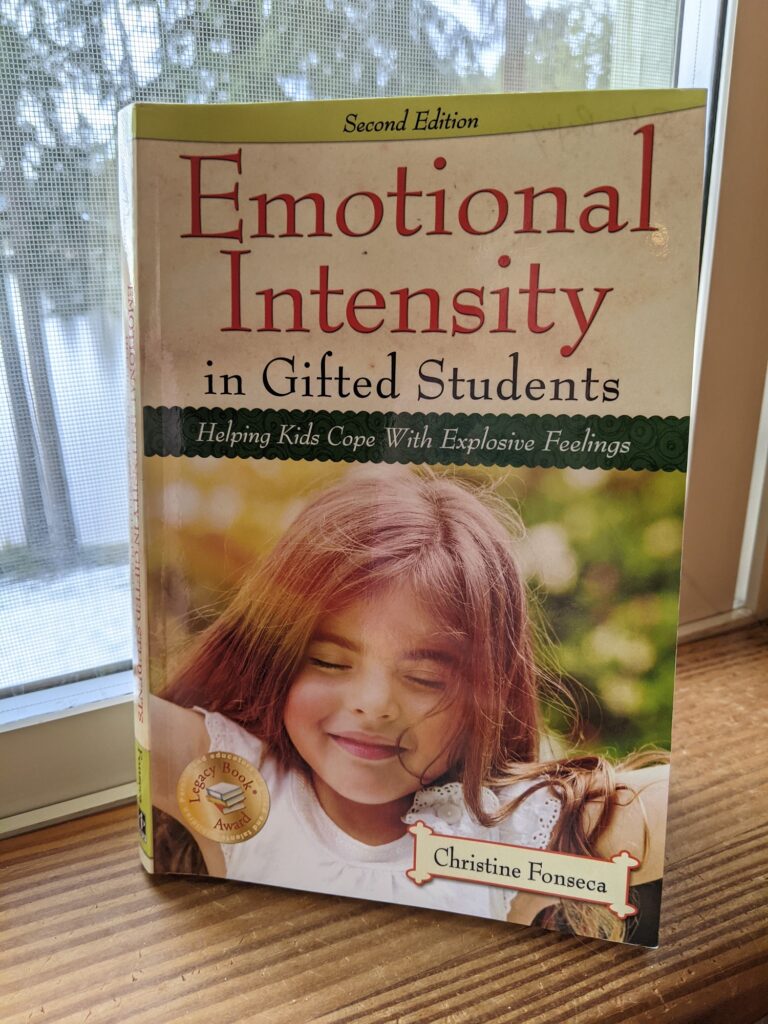
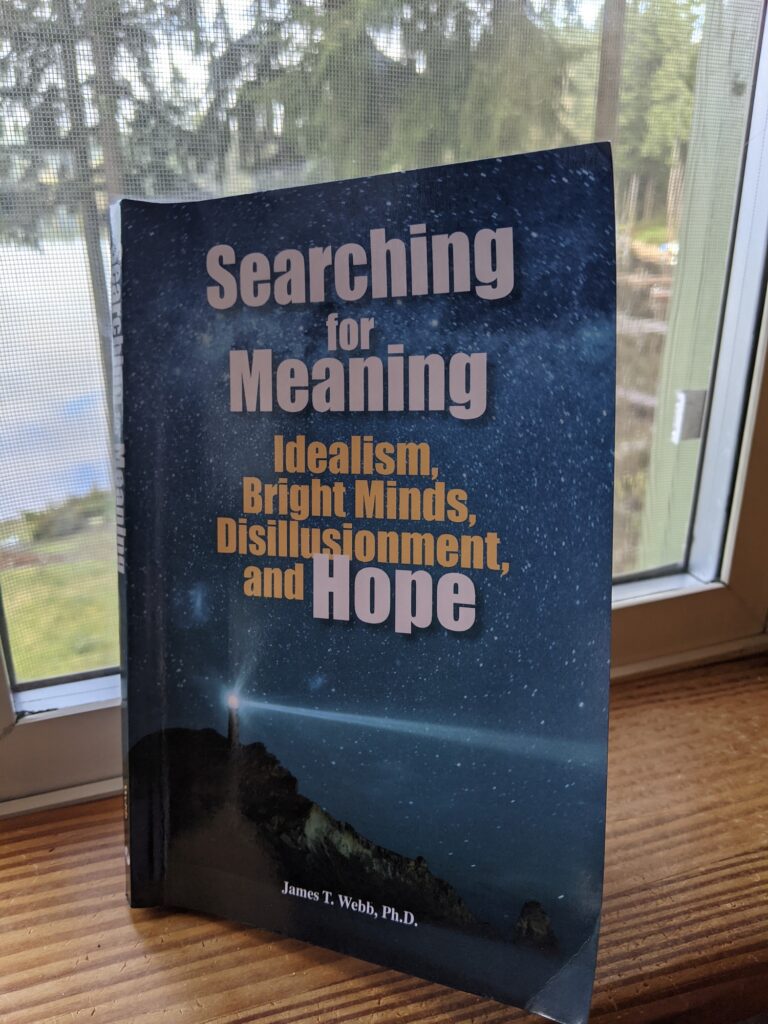
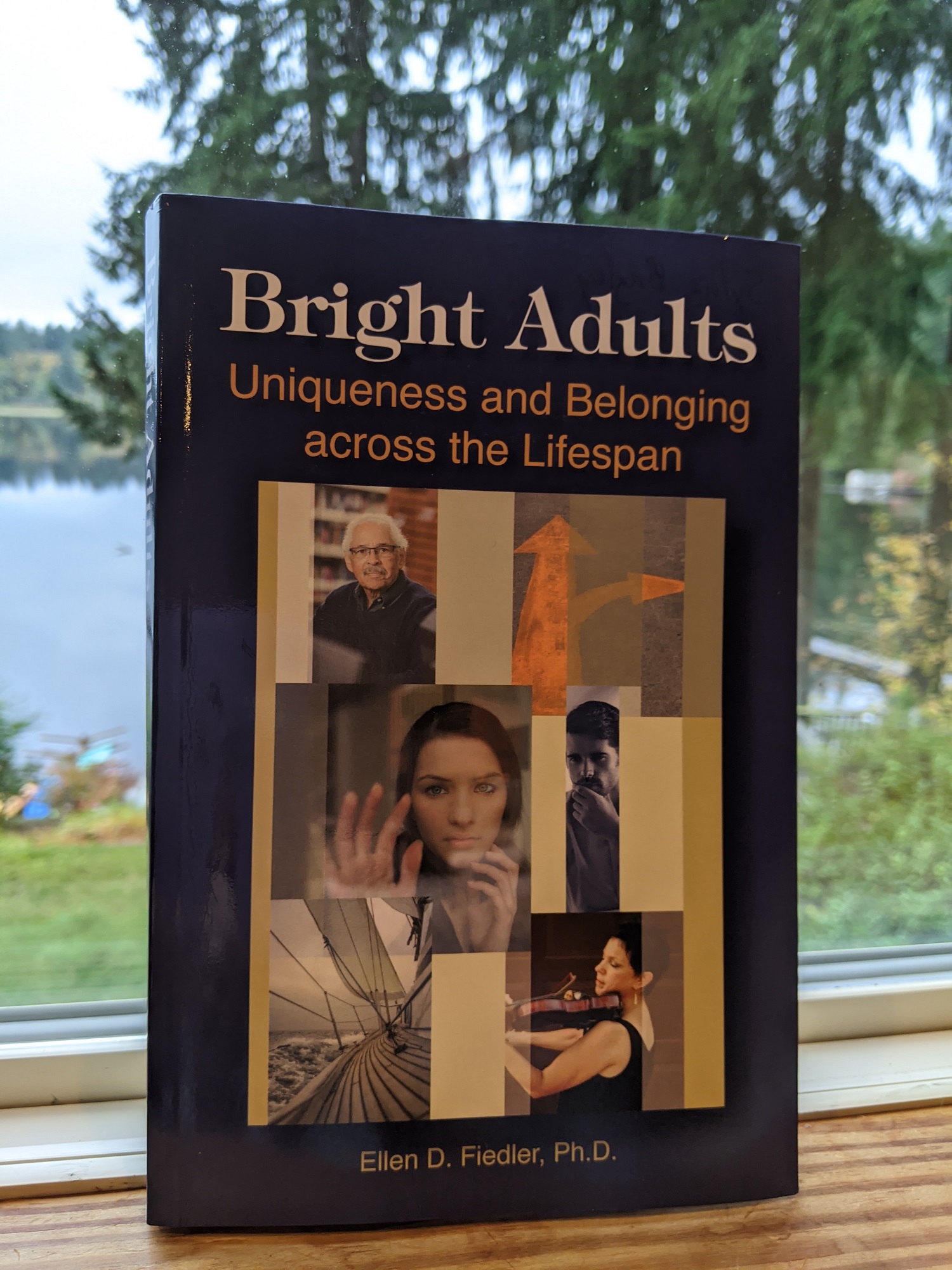
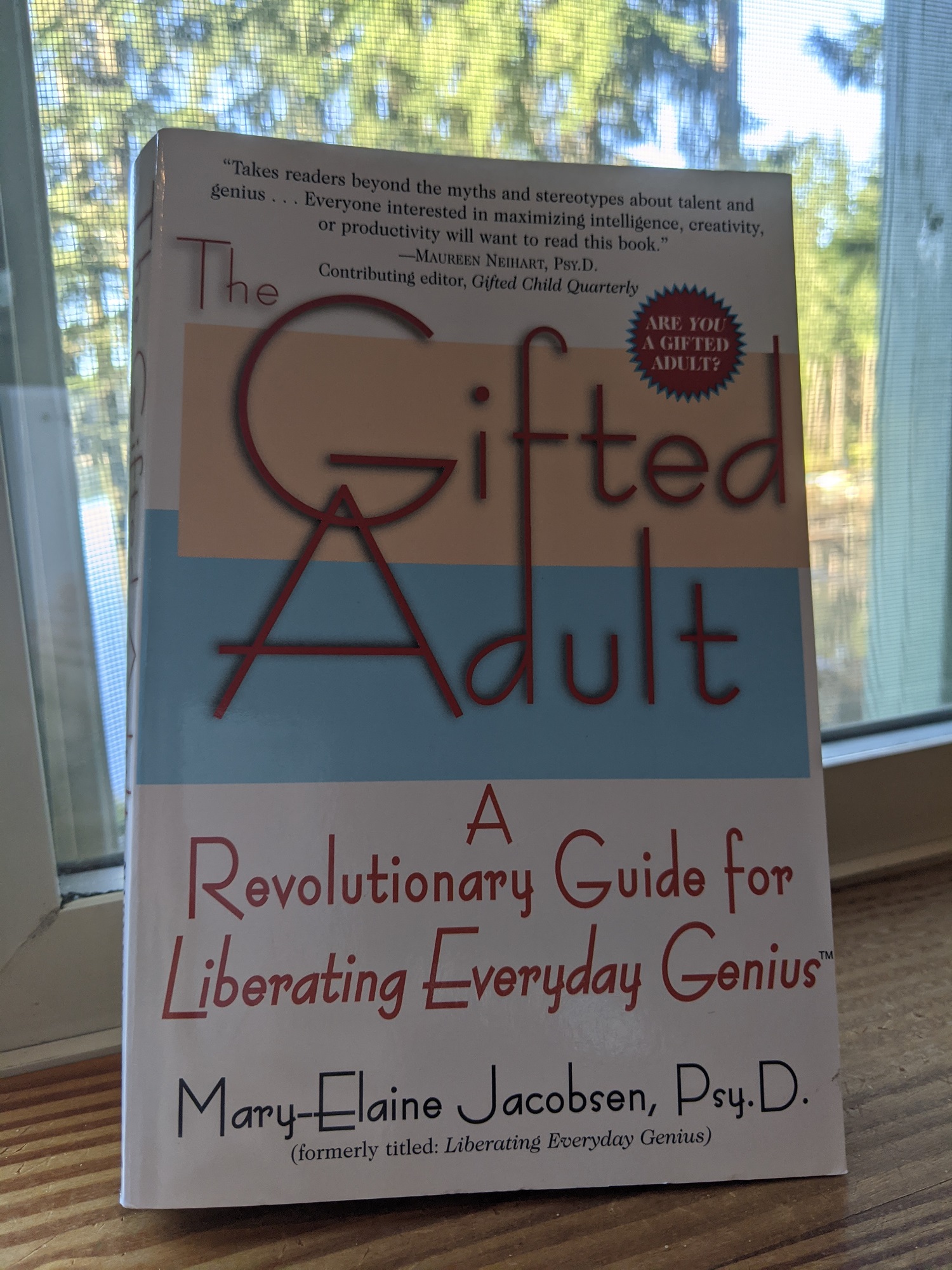
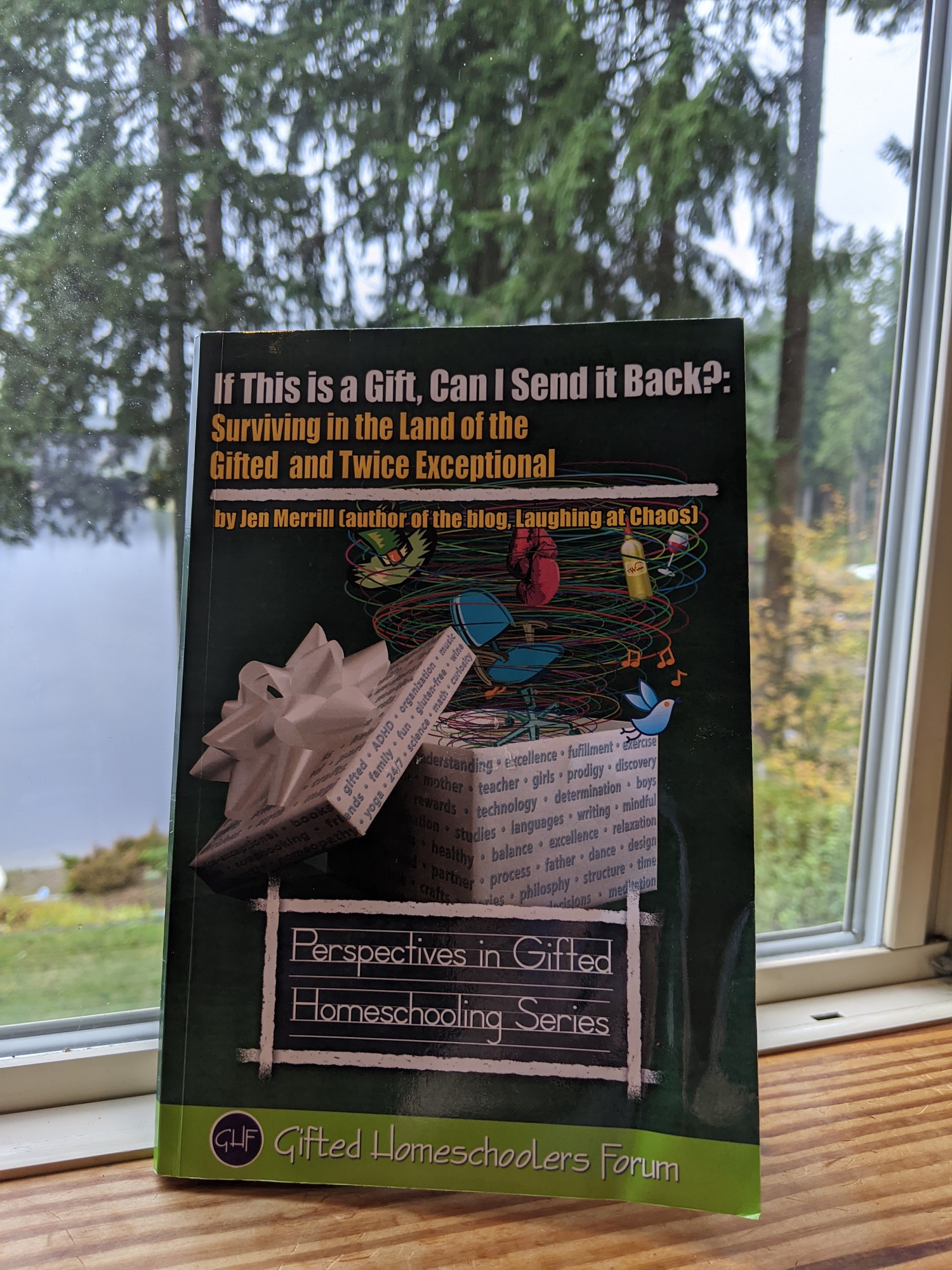
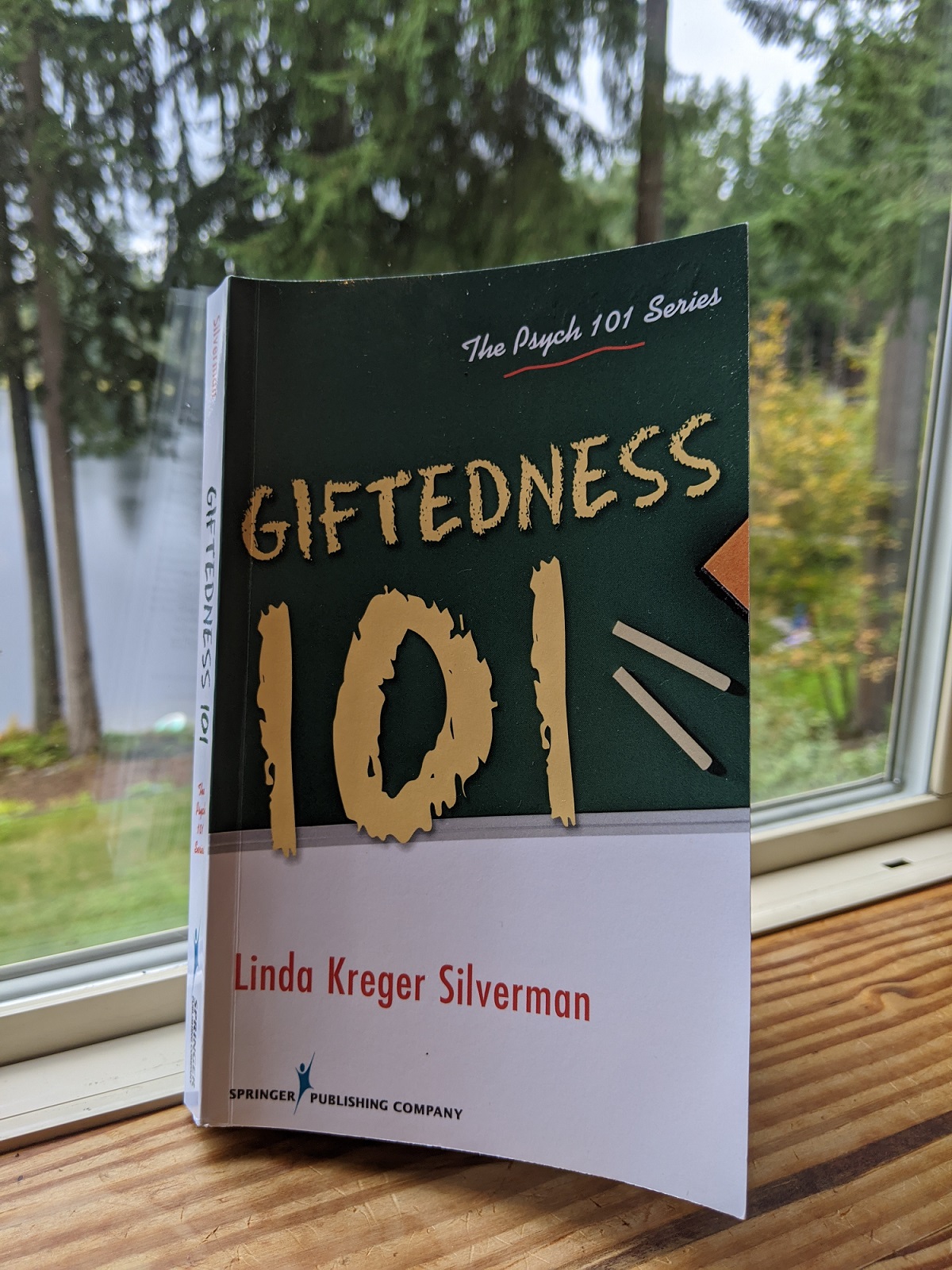 This is the first entry in what I hope will be an ongoing series of reflections on books related to giftedness and 2E learning.
This is the first entry in what I hope will be an ongoing series of reflections on books related to giftedness and 2E learning.